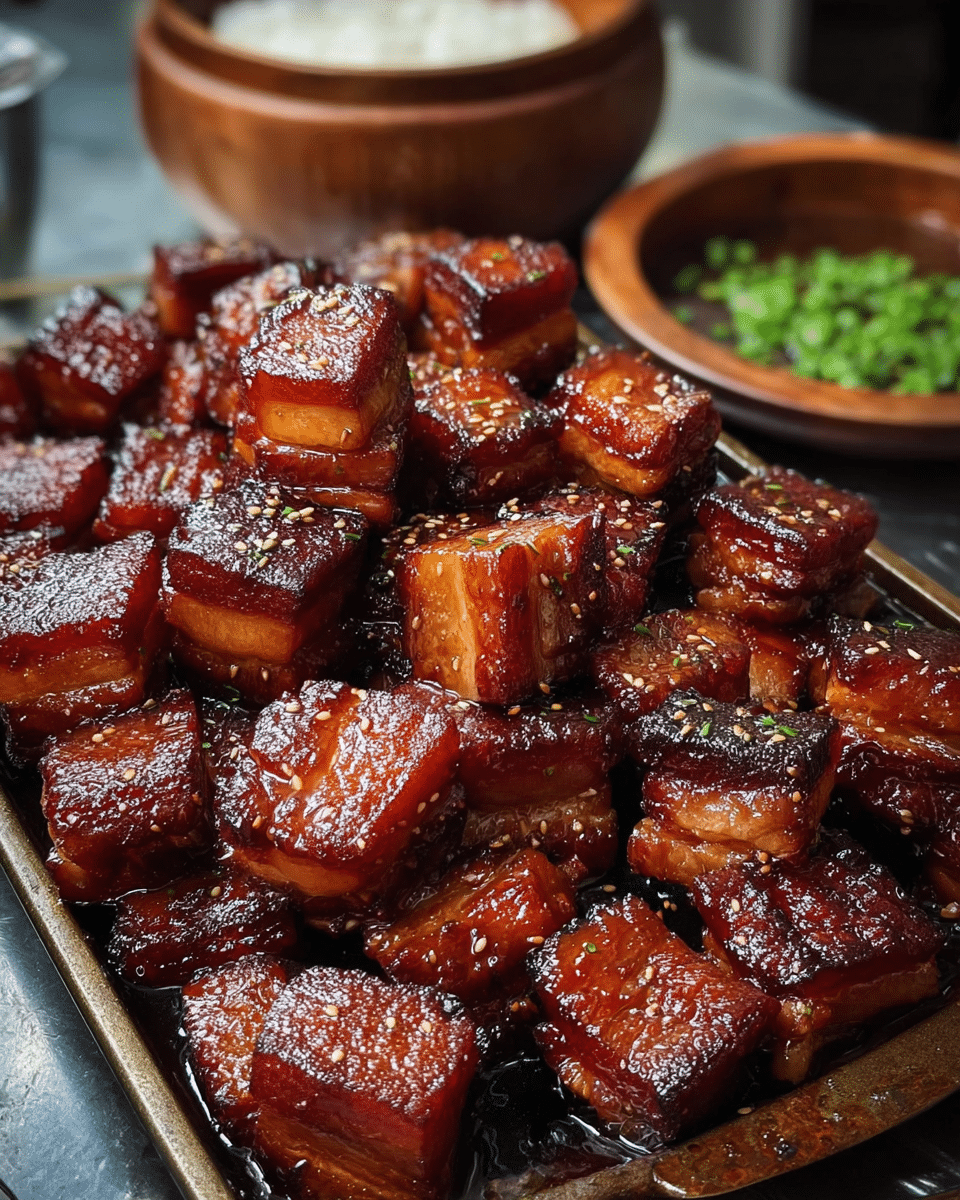Full Recipe:
Ingredients
-
1.5 pounds pork belly, cut into 1-inch pieces
-
2 tablespoons vegetable oil
-
4 cloves garlic, minced
-
1 thumb-sized piece of ginger, peeled and sliced
-
1/4 cup light soy sauce
-
1/4 cup dark soy sauce
-
1/3 cup Shaoxing wine (Chinese cooking wine)
-
1/4 cup hoisin sauce
-
1/4 cup brown sugar
-
1 cup water
-
2 green onions, chopped (for garnish)
-
1 tablespoon sesame seeds (for garnish)
Directions
-
Heat the vegetable oil in a large pan over medium heat.
-
Add the pork belly pieces and sear until browned on all sides, about 5-7 minutes.
-
Remove the pork belly from the pan and set aside.
-
In the same pan, add garlic and ginger, sautéing for 1-2 minutes until fragrant.
-
Return the pork belly to the pan and add light soy sauce, dark soy sauce, Shaoxing wine, hoisin sauce, brown sugar, and water.
-
Stir to coat the pork belly in the sauce.
-
Bring the mixture to a boil, then reduce the heat to low and simmer uncovered for 1-1.5 hours, or until the pork is tender and the sauce is thick and sticky.
-
Adjust seasoning as needed.
-
Serve hot, garnished with chopped green onions and sesame seeds.
Variations & Tips
-
Add a sliced red chili or chili paste for a spicy kick.
-
For a leaner option, substitute pork belly with pork shoulder or chicken thighs.
-
A splash of rice vinegar added near the end of cooking can provide a nice tangy contrast to the sweet and savory sauce.
Nutrients
-
Calories: 446 per serving
-
Carbohydrates: 13g
-
Protein: 21g
-
Fat: 35g
-
Sodium: 778mg
-
Fiber: 1g
-
Sugar: 9g
-
Vitamin A: 104 IU
-
Vitamin C: 7mg
-
Calcium: 45mg
-
Iron: 2mg
A Culinary Journey Through Flavors
At the heart of this dish lies the pork belly, known for its tender and juicy texture when cooked correctly. Pork belly has the perfect balance of fat and meat, which makes it ideal for slow cooking. As the pork belly simmers in the sauce, the fat renders, allowing the meat to become incredibly tender, almost falling apart with each bite. The sauce, rich with soy sauce, hoisin sauce, Shaoxing wine, and brown sugar, envelops the pork in a deep, savory sweetness that’s balanced by the savory umami of the soy sauce and the slight tang of Shaoxing wine.
The caramelization process brings out the natural sweetness in the brown sugar, and the hoisin sauce adds an additional layer of complexity, contributing its distinctive umami flavor. Each ingredient works harmoniously to create a mouthwatering dish that is both comforting and luxurious.
The Versatility of Sticky Chinese Pork Belly
One of the most appealing aspects of Sticky Chinese Pork Belly is its versatility. While the recipe calls for pork belly, it can be easily adapted to suit different tastes and dietary preferences. For a leaner version of the dish, you can substitute the pork belly with pork shoulder, which will still offer a tender texture but with less fat. Chicken thighs are another excellent alternative, offering a different but equally delicious flavor profile.
If you’re someone who enjoys a little heat in your meals, adding a sliced red chili or chili paste to the dish can give it an exciting spicy kick. The balance between the sweet, savory, and spicy elements creates a perfect harmony that many people find irresistible. You can also make the dish even more vibrant by incorporating fresh vegetables like bok choy, which can be sautéed on the side and adds a refreshing crunch that complements the rich pork belly.
Perfect Pairings
Sticky Chinese Pork Belly pairs beautifully with a variety of side dishes, but one of the most popular and classic accompaniments is steamed rice. The rice absorbs the delicious sauce, ensuring that every bite is packed with flavor. For those who prefer something a bit more robust, sautéed bok choy or stir-fried vegetables provide a crisp contrast to the richness of the pork belly. The bitterness of the bok choy also balances the sweetness of the sauce, creating a harmonious contrast that elevates the overall meal.
If you’re looking to round out the meal further, you could serve it with a simple soup or an appetizer like spring rolls. These light dishes help balance the heaviness of the pork belly while still offering authentic Chinese flavors.
Why Slow Cooking is Key
The key to making Sticky Chinese Pork Belly lies in the slow cooking process. By simmering the pork in the flavorful sauce for an extended period of time, the pork belly becomes incredibly tender, and the sauce reduces to a sticky, glossy consistency. Slow cooking ensures that the flavors penetrate the meat, making every bite packed with rich, umami goodness. It also allows the pork belly to absorb the sweet and savory flavors of the sauce, creating a depth of taste that’s difficult to achieve with quicker cooking methods.
The slow cooking process also renders the fat in the pork belly, which helps to keep the meat moist and juicy. This technique is why pork belly is so often used in braised dishes – the fat helps prevent the meat from drying out, resulting in a luscious, tender texture that is the hallmark of this dish.
Why This Dish Is Loved
Sticky Chinese Pork Belly is a dish that perfectly captures the essence of Chinese cooking: balancing flavors, textures, and ingredients to create something both simple and extraordinary. The rich, sticky sauce is the star of the show, but the tender pork belly steals the spotlight. Each bite is an indulgence, with layers of flavor that are at once comforting and complex. Whether you enjoy it for a special occasion or simply as a weeknight treat, Sticky Chinese Pork Belly is a dish that offers something for everyone.
Conclusion: A Dish Worth Savoring
In conclusion, Sticky Chinese Pork Belly is more than just a meal; it’s an experience. From its tender, melt-in-your-mouth pork belly to its rich, caramelized sauce, this dish is a celebration of flavor. It’s a perfect example of how simple ingredients can come together to create something truly special. Whether you follow the traditional recipe or add your own twists, this dish is bound to become a favorite in your culinary repertoire.
Sticky Chinese Pork Belly is a dish that appeals to both seasoned cooks and beginners alike, offering a delightful balance of flavors that are both satisfying and unforgettable. The versatility of the recipe allows for customization, so you can easily cater to your tastes or dietary preferences. Whether you serve it with steamed rice, sautéed bok choy, or your favorite side, this dish is sure to impress. So go ahead and try it – you won’t regret it!






